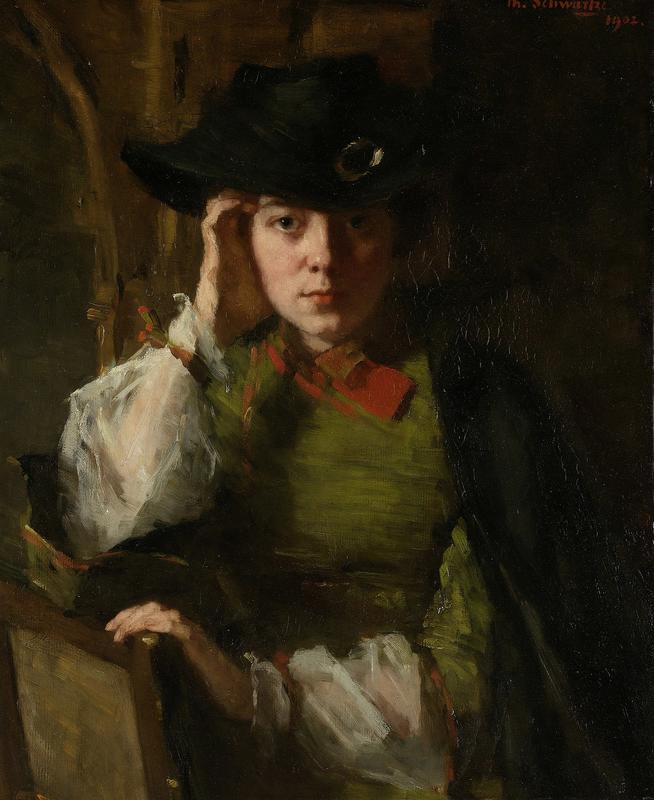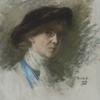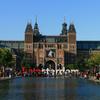More about Portrait of Lizzy Ansingh

Contributor
One of the best works of Thérèse Schwartze, purchased by the Rijksmuseum from Sotheby's in 1977, the Portrait of Lizzy Ansingh is an intimate conversation between an aunt (the artist) and her niece (Ansingh), who were both determined to pursue painting as a vocation amidst a storm of nay-saying by people who felt that upper-class women shouldn't pursue careers.
Some of these naysayers eventually agreed that women were inevitably going to make art, but they held that women should pursue only "female subjects" and stay away from the mens' worlds of history painting, figure studies, and so on. Every step of the way, Schwartze and Ansingh fought for the right to work as painters. Schwartze's father, Johann Georg Schwartze, a truly cosmopolitan artist, was born to German parents in Amsterdam. By the time his wife, Koblenz Maria Elisabeth Therese Herrmann, gave birth to Thérèse, Johann Georg was determined to have one of his children continue the family name in oil painting, and he chose Thérèse, of the six children, as his successor, coaching her with all the "obsessiveness of a tennis parent," according to Schwartze biographer Cora Hollema.
Like Johann Georg, Lizzy Ansingh was a member of the Arti et Amicitiae artists' society in Amsterdam, which coalesced as a form of communal and financial support for artists as the guild system was crumbling. At the dawn of the Arti et Amicitiae group, Napoleon had conquered the Netherlands and decided, in typically self-interested dictatorial fashion, that all art should be like Jacques-Louis David's, a tool for the ambitions and public relations of statecraft, rather than a representation of the spirit of the artists themselves. From a devout household, Ansingh started out by painting religious scenes before receiving her first drawing lessons from her aunt Thérèse. She lived with her from 1892 to 1908, right after Schwartze hyphenated her last name, adding "van Duyl" (which the Dutch pronounce like "fon Dial") to reflect her recent marriage. Both Schwartze and Ansingh were socially and intellectually close with George Hendrik Breitner, which, in the eyes of critics, was stranger than the friendship of Milo and Otis. On the one hand, Breitner was the epitome of the avant-garde, painting from photographs everyday women on the street which he, unlike most artists, admitted to using as his models. On the other hand, although she also used photographs as part of her lightning-fast "wet on wet" method of painting, which required her to finish her works within 72 hours of starting them, Schwartze was the créme de la créme of the financial and royal elite, and the main criticism of her, aside from the sexist ones, was the absurd idea that she was not avant-garde enough.
Sources
- Bergvelt, Ellinoor, Peter Jan Knegtmans, and Marian Schilder. Colourful professors: 375 years of portraiture in the collection of the Universiteit van Amsterdam. Amsterdam: Amsterdam University Press, 2007.
- MBW Broekema. "Ansingh, Maria Elisabeth Georgina (1875-1959)." Huygens, 1989, http://resources.huygens.knaw.nl/bwn1880-2000/lemmata/Index/bwn3/ansing….
- "De Amsterdamse Joffers schrijven geschiedenis." Tamai Foundation, https://www.tamai.nl/nl/blog/de-amsterdamse-joffers-schrijven-geschiede….
- Kuitenbrouwer, Vincent. War of Words: Dutch Pro-Boer Propaganda and the South African War (1899-1902). Amsterdam: Amsterdam University Press, 2012.
- "Portrait of Lizzy Ansingh, Thérèse Schwartze, 1902." Rijksmuseum, https://www.rijksmuseum.nl/en/collection/SK-A-4700.
- Shaw, Albert. The American Monthly Review of Reviews, Volume 21. New York: Review of Reviews, 1900.
- "STROMING: AMSTERDAMSE JOFFERS." Mark Smit Kunsthandel, https://www.marksmit.nl/stroming/amsterdamse-joffers/.











